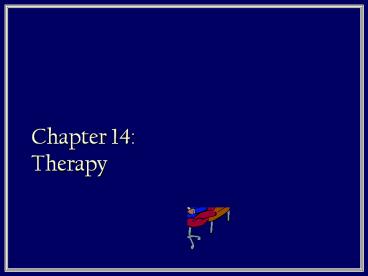Chapter 14: Therapy - PowerPoint PPT Presentation
1 / 12
Title:
Chapter 14: Therapy
Description:
Chapter 14: Therapy Freud s Approach: Psychoanalysis Aims To bring to light the repressed and conflicted impulses of the Id-ego-superego Methods Client talks (free ... – PowerPoint PPT presentation
Number of Views:153
Avg rating:3.0/5.0
Title: Chapter 14: Therapy
1
Chapter 14 Therapy
2
Freuds Approach Psychoanalysis
- Aims
- To bring to light the repressed and conflicted
impulses of the Id-ego-superego - Methods
- Client talks (free-associates) and the analyst
interprets and provides insight - Common contemporary approaches
- Psychodynamic therapy
- Interpersonal psychotherapy
3
Rogers Approach Humanistic Therapies
- Client-centered approach
- Works to increase self-awareness
self-acceptance personal growth - Methods
- Talk about current and future events
- No emphasis on the unconscious
- Taking responsibility
- Therapist uses active listening paraphrase,
clarify, reflect feelings
4
Behavior Therapies
- The aim of these therapies is behavior
modification - Methods
- Classical conditioning
- Counter-conditioning
- Systematic desensitization
- Aversive conditioning
- Operant conditioning
- Token economy
5
Cognitive Therapies
- These approaches recognize the influence of
thinking upon our feelings - Methods
- Change the way we feel by changing the way we
think - Cognitive-Behavior Therapy (CBT)
- Thoughts? Feelings? Behaviors
6
Group and Family Therapies
- All the therapies we discussed today (except
psychoanalysis) can be done on an individual or
group basis - Family therapy
- Benefits of group therapy
- Low cost
- Increased support
- Sense of community not alone with a problem
7
Biomedical Approaches
- Weve talked a bit about drug therapies already
- Became popular in the mid-1950s with the
discovery of antipsychotic medications - Led to a huge reduction in the number of
hospitalizations - The major classes of psychotropic medications
8
Other Biomedical Interventions
- Electroconvulsive therapy (ECT) or shock therapy
- Psychosurgery
9
How do we Know if Therapy Works?
- This is not an easy question to answer
- Client testimonials
- Crises tend to abate with time
- Positive expectations can lead to positive
results - Need to believe it was worth the effort
- Liking therapist can influence report
10
Does it work? Cont.
- Therapists themselves also report high rates of
success - People come in very unhappy and leave happier
- Can they tell what made the difference?
- Problems with objective, measurable behaviors
like OCD are easier to evaluate - Outcome research
11
Are some therapies better than others?
- There really is no winner when you compare all
of the therapies - What is important is finding a match between
- The problem and the approach
- The client and the therapist
12
What all Therapies do have
- Hope
- A new perspective and insight
- Empathy
- Trust
- Caring































